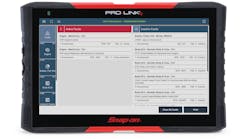The leaders of J.B. Hunt Transport Services Inc. have in the past year repeatedly said they were taking the upbeat forecasts of some of their clients with a grain of salt. Late in 2023, that stance paid off with a positive surprise—for a change.
J.B. Hunt’s large intermodal operation saw a peak season that division President Darren Field said “neither we, nor our customers, nor our rail providers were expecting,” with load count rising 6% from the last three months of 2022 to nearly 536,000. On top of that, J.B. Hunt’s average intermodal length of haul climbed 2.4% to 1,703 miles and growth picked up during the quarter, peaking at 8% during December.
“The coiled spring unlocked a little bit and we were able to spread growth volume over more loads,” Field told analysts on a conference call.
See also: Continued freight weakness weighs on J.B. Hunt margins
Still, Field and his fellow executives aren’t prepared to call anything close to a market turn. Many customers are still under pressure and unwilling to take price increases—intermodal’s revenue per load fell nearly 13% during Q4—and more capacity still needs to leave the market, they said. That said, Field did note that, absent price hikes, “volume in our current state is worth more to us than it ever has been in our past given the asset count that we currently own.”
The weak pricing and demand environment showed in J.B. Hunt’s fourth-quarter results: For the three months ended Dec. 31, the Arkansas-based company produced a net profit of nearly $154 million, down from $201 million in late 2022, on total operating revenues of $3.3 billion versus more than $3.6 billion. The company’s dedicated, final-mile, and truckload units all registered fewer loads than in the prior-year quarter, and J.B. Hunt’s overall operating margin fell to 6.2% from 7.7%.
As in late 2022, CEO John Roberts and his team needed to book a big Q4 charge to account for insurance losses. This time, the charge was $53.4 million—about $10 million less than a year prior—and Roberts kicked off J.B. Hunt’s conference call by railing against rising insurance costs across the industry while also pointing out that J.B. Hunt needed to take its charge despite putting up its best-ever safety numbers in 2023.
“We think we’re out leading well on the safety side, but the fact is that the individual claims are just going through the roof, and […] those are in state courts,” COO and President of Contract Services Nick Hobbs said later during the call. “It's a state-by-state [issue] that’s got to be addressed. We’re working with the American Trucking Associations and trying to go state by state to get tort reform. So it's going to be a long battle there unless there is some federal legislation.”
The J.B. Hunt team’s lack of enthusiasm about bid season trends or a broader improvement in the freight market echoes the tone of a report earlier this week from analysts at Stifel. Director Bruce Chan and his team said that, despite some second-half improvement in volumes and inflation receding, they are taking a “more conservative” view of growth prospects in 2024 since many customers are unlikely to commit to restocking inventories they’ve only just satisfactorily managed down.
“Given some of the indicators that we're seeing on the consumer side of things, and given many shippers have trepidation about the direction of the economy, those inventories will probably be a little bit slower to recover,” Chan said.
Investors appeared to be willing to see the silver lining of J.B. Hunt’s Q4 report. Shares of the company (Ticker: JBHT) rose more than 3% to $203.50 in after-hours trading Jan. 18 after climbing about that much during the regular session. Over the past six months, they are essentially flat, leaving the company’s market capitalization at about $20 billion.




